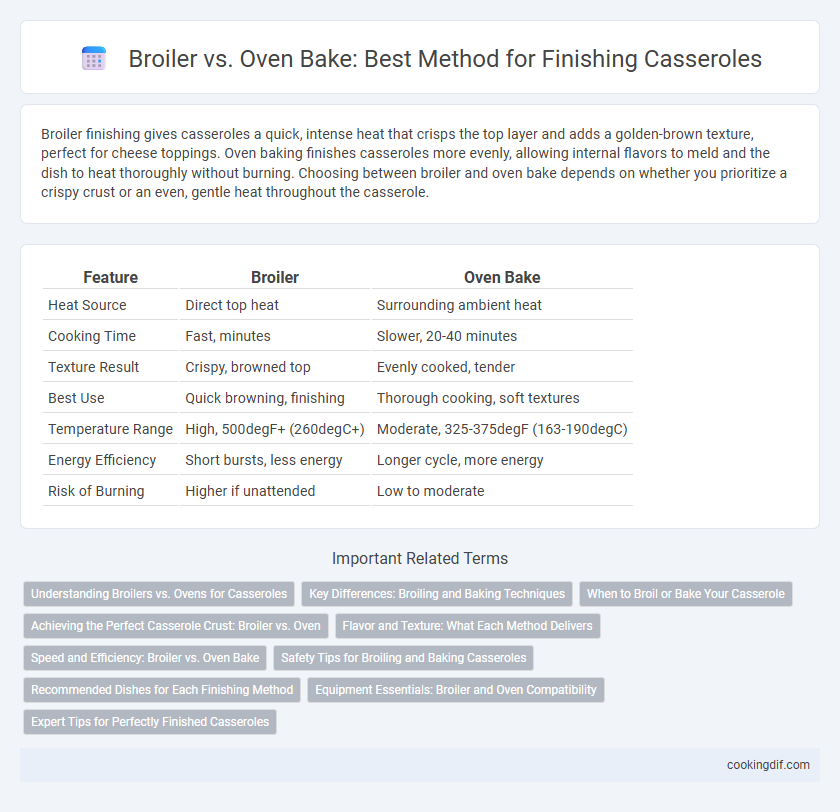Broiler finishing gives casseroles a quick, intense heat that crisps the top layer and adds a golden-brown texture, perfect for cheese toppings. Oven baking finishes casseroles more evenly, allowing internal flavors to meld and the dish to heat thoroughly without burning. Choosing between broiler and oven bake depends on whether you prioritize a crispy crust or an even, gentle heat throughout the casserole.
Table of Comparison
| Feature | Broiler | Oven Bake |
|---|---|---|
| Heat Source | Direct top heat | Surrounding ambient heat |
| Cooking Time | Fast, minutes | Slower, 20-40 minutes |
| Texture Result | Crispy, browned top | Evenly cooked, tender |
| Best Use | Quick browning, finishing | Thorough cooking, soft textures |
| Temperature Range | High, 500degF+ (260degC+) | Moderate, 325-375degF (163-190degC) |
| Energy Efficiency | Short bursts, less energy | Longer cycle, more energy |
| Risk of Burning | Higher if unattended | Low to moderate |
Understanding Broilers vs. Ovens for Casseroles
Broilers deliver intense, direct heat from above, ideal for quickly crisping or browning the casserole topping, while ovens provide even, ambient heat suitable for thorough baking and cooking of the entire dish. Choosing broiler finishing enhances textures in casseroles like macaroni and cheese or gratins, whereas oven baking ensures uniform heat distribution, preventing overcooking of edges. Understanding the temperature control and heat source differences between broilers and ovens enables precise finishing techniques for optimal casserole results.
Key Differences: Broiling and Baking Techniques
Broiling uses intense, direct radiant heat from above to rapidly brown and crisp the casserole's surface, creating a caramelized texture in minutes. Baking cooks the casserole evenly with surrounding dry heat at lower temperatures, ensuring thorough heat penetration and consistent texture throughout. Broiling is ideal for finishing touches and browning, while baking is essential for fully cooking and setting the casserole layers.
When to Broil or Bake Your Casserole
Broiling a casserole is ideal for achieving a crisp, browned top in the final minutes of cooking, especially when the dish is already fully cooked and just needs a golden finish. Baking is best for casseroles that require even, thorough cooking throughout, allowing ingredients to meld and heat uniformly over a longer period. Choose broiling for quick browning and oven baking to ensure the casserole is heated evenly from the inside out.
Achieving the Perfect Casserole Crust: Broiler vs. Oven
Using a broiler to finish a casserole provides intense direct heat that quickly crisps and browns the top, creating a golden, crunchy crust ideal for dishes with cheese or breadcrumbs. Oven baking, on the other hand, applies even, gentle heat that allows the casserole to cook through uniformly while gradually developing a softer, less intense crust. For a perfectly balanced casserole crust, broiling is best for rapid browning and texture contrast, whereas oven baking ensures thorough cooking with a mild crust finish.
Flavor and Texture: What Each Method Delivers
Broiling a casserole caramelizes the top layer, creating a crispy, golden crust that enhances flavor through Maillard reactions while retaining a moist interior. Oven baking evenly heats the entire dish, ensuring thorough cooking and a tender, cohesive texture without overly drying the surface. Choosing broiler finishing intensifies texture contrast, whereas oven baking delivers consistent doneness throughout.
Speed and Efficiency: Broiler vs. Oven Bake
Broiling a casserole finishes it quickly by applying intense, direct heat from above, making it ideal for browning and crisping toppings in minutes. Oven baking provides even, consistent heat around the dish, ensuring thorough cooking but typically requires longer time compared to broiling. For speed and efficiency, broiling delivers rapid results for surface textures, while oven baking ensures complete, uniform cooking throughout the casserole.
Safety Tips for Broiling and Baking Casseroles
Broiling casseroles requires maintaining a safe distance from the heating element to prevent burning and using oven mitts to avoid burns when handling hot dishes. Baking casseroles at consistent temperatures ensures thorough cooking and reduces the risk of undercooked food, which can harbor harmful bacteria. Always use oven-safe cookware rated for high temperatures to prevent cracking or melting during both broiling and baking.
Recommended Dishes for Each Finishing Method
Broiler finishing is ideal for casseroles with cheese toppings like gratins or dishes needing a crispy crust such as mac and cheese. Oven baking suits layered casseroles like lasagna and shepherd's pie that require even heat to meld flavors and thoroughly cook ingredients. Selecting the appropriate method ensures optimal texture and flavor enhancement for each specific casserole type.
Equipment Essentials: Broiler and Oven Compatibility
Broilers provide intense, direct heat ideal for achieving a golden, crispy top on casseroles, while ovens ensure even, consistent cooking throughout the dish. Choosing equipment with adjustable broiler settings and proper rack placement enhances the finishing process without overcooking the casserole base. Compatibility between broiler and oven functions in a single appliance streamlines finishing techniques and improves overall texture and flavor.
Expert Tips for Perfectly Finished Casseroles
Broiling a casserole provides intense, direct heat that crisps and browns the top layer quickly, ideal for achieving a golden crust. Oven baking ensures even heat distribution, allowing the casserole to cook thoroughly and maintain moisture throughout. Experts recommend starting with baking to cook the interior, then finishing under the broiler for 2-3 minutes to perfect the texture and color without drying out the dish.
Broiler vs Oven bake for casserole finishing Infographic

 cookingdif.com
cookingdif.com